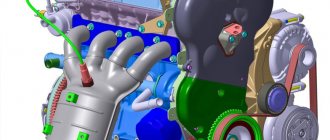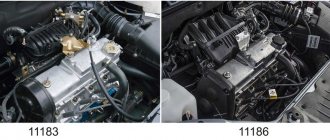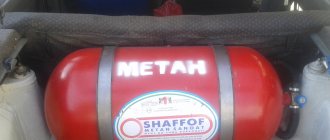AvtoVAZ is developing its 16-valve engines gradually, that is, step by step. When the updated Kalina family appeared in 2013, buyers were perplexed as to why they offered a 106-horsepower engine in manual versions, which differed little in design from the usual Priora engine.
The new engine was equipped with resonant supercharging, and it seemed that its presence would only have disadvantages: reliability was reduced, there was no way to connect the cable drive. But it turned out that the new engine was no worse than its predecessor: the mass air flow sensor often breaks down, and the DBP and DTV sensors almost never. There is no MAF sensor in the design of the 27th engine, which is the secret of increased reliability.
By the way, Lada Vesta with a Nissan engine is getting ready for release!
What engine is in the 1.6 liter Lada Vesta?
What kind of engine the Lada Vesta originally had was the VAZ 21129. Designed and produced by AvtoVAZ, it was installed on these cars at the beginning of the launch of the series. Its predecessor was the VAZ 21127. Compared to its ancestor, this engine is more advanced thanks to modern air supply and good dynamic characteristics. In addition, it has temperature and absolute pressure sensors. Another distinctive feature is the unique intake manifold flap system. The VAZ 21129 power unit operates stably at any speed, allows you to control the composition and quality of the fuel mixture, and does not allow floating speeds to be created at idle. Has the following technical parameters:
- volume – 1.6 l;
- power – 106 hp;
- drive – toothed belt;
- torque 148/4200;
- weighs 109.2 kg;
- electronic starting system;
- distributed fuel injection;
- in 12.8 sec. accelerates to 100 km/h;
- resource 200 thousand km.
This engine is powered by 95-grade unleaded gasoline. The gasoline consumption figures indicated in the manual are 10.2 liters on city streets, 6.2 liters outside the city, 7.5 liters with mixed driving. In terms of toxicity level, VAZ 21129 meets the requirements of the Euro-5 standard.
In addition, this engine can boast a cylinder block of higher rigidity than its predecessors, modern fuel and lubrication supply routes, a modern engine suspension, and an improved exhaust gas emission system. It has a lightweight (again, if you look at its predecessor) connecting rod and piston group, the pistons themselves have a shortened aluminum alloy skirt. Contact with the valve is excluded, even if the belt breaks. Thin oil scraper and compression rings reduce friction losses, which contributes to greater fuel efficiency. It is equipped with both a manual transmission and an automatic transmission. In addition, this engine can be tuned, “overclocking” up to 150 horsepower.
see also
Comments 30
If you plan to take the SW version (because it’s not clear from the text), then only 1.8. Because the station wagon with 1.6 will be completely dead.
And if it’s a sedan, then 1.6 will be the norm. It is quite obvious that 1.6 will be more practical to maintain.
Of course, take the 1.6, it’s simpler, more reliable, more economical, and just take it with a manual transmission, the robot won’t drive
The 1.6 Prioro engine is updated, and the 1.8 Prioro engine is updated with an increased volume of 0.2 liters. I would take a 1.8 liter and pump it up to 150-160 horses!
but it seems like 1.6 can also be pumped up and it will be easier to do.
I read somewhere that changing the belt on 1.8 is a whole story, you almost need to remove the engine, with 1.6 it will be easier for you and the craftsmen!
I wanted 1.6, I had to buy 1.8) 1.8 is more elastic, pulls better in higher gears
IMHO 1.6 the explanation is simple: Reliable Well-known In the city, both 1.8 and 1.6 are not racing cars, 1.6 is enough for me even with a load... Potential advantages of 1.6 are the ability to install a self-block and, if desired, there are kits for maniacs to increase the power to 140+ horses. For 1.8, a Renault box, which means spare parts are more expensive and less common...
Well, the main thing is to run the engine in normal conditions and even the 1.6 will go very cheerfully
PS... In minus 1.8 this is an OD attitude towards it, they say there are a lot of complaints, it’s not for nothing that VAZ released a new firmware for it...
There are self-blocks for both rental boxes.
Price? It seems to me that the VAZ box is cheaper and installation is cheaper
10-satellite AVT 18-20 thousand. Yes, VAZ is two and a half times cheaper. I think the installation costs the same, unless of course the service charges for “foreign brand”))
I think repairs and availability of spare parts are approximately the same and, in principle, should be purple), sometimes people wait for a month for some kind of garbage - depending on your luck. For myself, I didn’t consider 1.6 at all because 106 mares for such a mass is clearly not enough, as I understand it, the oil eats a little, especially if you borscht while warming up. The 1.8 is especially good at low end, seemingly due to the intake phase shifter. In general, the story with AvtoVAZ is simple for me - before purchasing, be prepared to check the warranty a couple of times in the first year, and then without any problems, somewhere up to 70-90k
So, when deciding on purchasing a car, you decided on the Lada Vesta, but the dilemma is which engine in the Lada Vesta is better, 1.6 or 1.8. In this case, it is worth taking a closer look at their components and understanding which engine will be the better choice in which situation.
What engine is in the 1.8 liter Lada Vesta (cross)?
This is VAZ 21179, another (more modern and powerful) brainchild of AvtoVAZ. And in general, the first 1.8-liter engine produced by this domestic automaker. Outwardly similar to its Russian counterparts, which have 16 valves, but are more powerful, more dynamic, and have variable valve timing. Has the following technical characteristics:
- volume 1.8 l;
- power 122 hp;
- drive from the German manufacturer INA;
- torque 170/3750;
- weighs 110.1 kg;
- electronic starting system;
- accelerates to 100 km/h in 12 seconds;
- resource 300 thousand km.
Like its 1.6-liter brother, it runs on 95 AI and complies with Euro-5 requirements. Gasoline consumption recommended by the manufacturer: in a populated area 10 liters, in mixed mode 8 liters, on the highway 6-7 liters. What engine does the Lada Vesta Cross have? - just VAZ 21179.
The power unit has intake and exhaust valves in a lightweight and enlarged version, and starts and accelerates quickly and calmly. Pairs perfectly with the traditional semi-automatic VAZ gearbox. Some engine components are made in Russia, and some parts (for example, valves and an oxygen sensor) are made by foreign manufacturers.
VAZ-21129
The VAZ-21129 engine model has significantly more power and attractiveness. Unlike the VAZ-11189, this variation with the same engine volume of 1.6 liters has a power of 106 horsepower. The main difference leading to this difference in power is the number of valves. On the VAZ-11189 there are only eight of them, but in this version there are sixteen.
This engine of the new Lada Vesta will, in all likelihood, be available in the basic configuration, while for Grants and Priora it was installed only in Luxury vehicles. However, taking into account the greater mass of Vesta, the maximum speed and acceleration of the car are unlikely to be more powerful and pronounced than that of the same Priora on the VAZ-11189.
It is known for certain that the Lada Vesta hatchback will be equipped with power units of this type, and the VAZ-21129 will be available when purchasing the “Classic” model complete with a manual transmission. In general, the engine performs well on Russian roads. The only thing you should pay careful attention to is the timing belt: if it breaks, the engine valves can quickly become unusable. If you avoid such problems, the durability of the Lada Vesta engine is quite long.
The disadvantage of the VAZ-21129 is the high level of noise generated, which, among other things, is not always even. After prolonged use, an engine, even in relatively good condition, may begin to knock and trip.
Renault-Nissan H4M-HR16 DE
The only foreign-made internal combustion engine in the Lada Vesta is the H4M-HR16 DE, manufactured by the joint company Renault-Nissan. Its main difference from the two above-mentioned engines is the absence of a timing belt. Instead, a chain is installed, which is much more reliable and cheaper in terms of use and repair. Engine Specifications:
- volume – 1.6 l;
- power – 114 hp;
- drive and timing – chain instead of belt;
- torque 153/4400;
- weighs 109.1 kg;
- electronic starting system;
- distributed injection;
- accelerates to 100 km/h in 12.2 seconds;
- resource 250 thousand km.
This engine consumes 92 and 95 gasoline and methane. The standard consumption in a populated area is 8.2 liters, on highways 5.4 liters, and in mixed driving 6.3 liters. Like its brothers, it adheres to Euro-5 toxicity standards. The H4M-HR16 DE engine is the most expensive among all three installed on Vesta, but also the most reliable in operation. Powerful, dynamic, comfortable, at the same time it “eats” little fuel. Distinctive features of the engine also include increased piston sizes and crank radius, improved, more economical oil passages and some other upgrades.
Specifications
Technical characteristics of the HR16DE motor:
Download .xls file
xls
Download picture
Send by email
| PARAMETER | MEANING |
| Years of manufacture | 2006 – present |
| Cylinder block material | aluminum |
| Supply system | injector |
| Type | in-line |
| Engine displacement | 1.8 |
| Power | 110 horsepower at 6000 rpm |
| Number of cylinders | 4 |
| Number of valves | 4 |
| Piston stroke | 83.6 |
| Cylinder diameter | 78 |
| Compression ratio | 9.5 |
| Torque, Nm/rpm | 153 Nm / 4400 |
| Environmental standards | EURO 5 |
| Fuel | AI 92 |
| Fuel consumption | 6.9 l/100 km combined cycle |
| Oil | 5W-30 – 15W40 |
| Oil volume | 4.6 |
| When replacing, pour | 4.3 liters |
| The oil change is carried out | 10 thousand km |
| Engine life - according to factory data - in practice | n.d. 250+ |
The engine is installed on Nissan Qashqai, Juke, Micra, Sentra, Note and Lada Vesta.
What kind of oil should I pour into the Lada Vesta engine?
The characteristics of the selected power unit are important. However, in order for it to show its best side, you still need to have an idea of what kind of oil to pour into the Lada Vesta engine. All three internal combustion engines installed on cars of this brand are high-speed, modern. Therefore, they require appropriate treatment. The manufacturer recommends (and fills at the factory) synthetic lubricants with a viscosity of 5w-30 and 5w-40 for domestic VAZ 21129 and VAZ 21179 engines and for foreign H4M-HR16 DE. This marking indicates the viscosity indicators of the product according to the international SAE classification. The letter w in the middle comes from the English word winter, which means winter. This means that lubricants marked with this letter are suitable for winter. The numbers on both sides of the letter are viscosity indicators at negative and positive temperatures. In this case, 5 and 30 mean that the optimal temperature range for using oil is from -35 to +30 degrees Celsius, and 5 and 40 - from -35 to +40 degrees. Taking into account the fact that Lada Vesta is a car focused primarily on Russian operating conditions, lubricants of this viscosity will be the optimal choice for most regions, all year round. As for tolerances, two domestic fuel and lubricants manufacturers have AvtoVAZ approvals - Lukoil and Rosneft. Accordingly, if you ask yourself what kind of oil was poured into the Lada Vesta engine from the assembly line, the answer will most likely be Lukoil Lux 5w-40 or Rosneft 5w-40. However, judging by the experience of motorists, oils produced by Shell, Mobil, Castrol and other popular brands have also proven themselves well if they have the appropriate specifications.
So, Lada Vesta has two engine sizes and three types of design. One of them is also installed on the Lada Vesta SV cross. When choosing a car, you should familiarize yourself with the characteristics of all three types of power units, compare and decide for yourself what power, what fuel consumption and what other qualities will be the best option.
Malfunctions
| FAULTS | CAUSES AND REMEDIES |
| The appearance of a whistle in the engine compartment. | The generator belt has stretched. It needs to be tightened or replaced with a new one. |
| The engine stalls. | The reason may be a failed ignition unit relay. The defective relay needs to be replaced, which can be done through a vehicle recall company. |
| An unpleasant sound appeared in the middle speed range. | The intake pipe gasket has burnt out. We replace the leaky gasket, which will eliminate the unpleasant roar of the engine. |
| The appearance of motor vibration. | The right airbag, which has a poor design, has failed. The damaged pillow needs to be replaced. |
What kind of gasoline should I fill according to the recommendations?
The regular Vesta and the SW modification with the listed types of internal combustion engines can be operated on AI-92 and 95 gasoline. At the same time, fuel with a lower octane number (AI-92) can be poured in case of urgent need.
In practice, many drivers refueled their cars with 98-octane gasoline. After using this brand of fuel, no negative changes in the operation of the internal combustion engine were noticed.
However, higher octane slightly improved driving dynamics and reduced consumption. The 16 and 18 year old engines are more suitable for domestic fuel.
Engine hr16de-h4m
The HR16DE-H4M is a powerplant jointly produced by Nissan and Renault.
AvtoVAZ received permission to produce this power unit in Russia in 2022. The engine not only has a number of advantages over the previous ones, but also has disadvantages. The main advantage of the HR16DE-H4M is its undemandingness regarding the type of fuel. The car will drive great both on the AI-95 and on the cheaper AI-92. The manufacturer also did not dare to install an unreliable belt and decided to install a strong chain.
The main disadvantage is the lack of hydraulic compensators. This is inconvenient, because every 100 thousand kilometers you will have to adjust the gaps. The HR16DE-H4M is not equipped with AMT - only a CVT and manual transmission.
It was also noticed that foreign-made engine mounts for LADA Vesta wear out quickly, which causes knocking and noise.
Common engine problems
The set of characteristic problems for 21129 has remained unchanged since the days of 21126 from the Lada Priora, of which it is a descendant. Engine tripping may occur: the reason often lies in clogged injectors, faulty ignition coils or spark plugs. Sometimes there are situations with valve burnout.
Another common problem with most 16-valve VAZ units is floating speed. Possible causes of manifestation:
- breakdown of the mass air flow sensor;
- throttle valve contamination;
- failure of the damper position sensor;
- Broken idle speed controller.
Another malfunction is that the engine may not reach operating temperature. The reason often lies in problems with the thermostat, or simply low temperature outside (then the engine needs insulation).
The engine refuses to start: you should check the electrics - coils, battery, spark plugs. The fuel pump or gasoline pressure regulator may fail, or the fuel filter may become clogged.
Knocking and extraneous noises from the engine compartment: hydraulic compensators are worn out, pistons, main and connecting rod bearings may also need to be replaced.
Engine vibration: the idle speed control or the armored wire is faulty; another probable cause is dirty injectors.
Real indicators based on reviews from car owners
The standard 1.6-liter engine is paired with a 5-speed manual transmission and a robot. The quality of the transmission as a whole does not cause any complaints from owners. Also, drivers often wonder what kind of gasoline is best to fill in the Lada Vesta? The manufacturer recommends refueling only with 95-octane gasoline; this information can be found in the vehicle documentation. This is important to take into account, because the nominal resource was determined taking into account many indicators, in particular, taking into account the octane number of the fuel.











